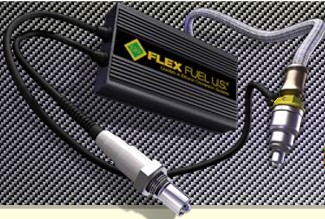Mar
12
Get Ready for $6 Gas with an E85 Ethanol Conversion or Build a Hotrod!
March 12, 2009 | Leave a Comment
One day, sooner or later oil prices will drive gasoline to very high prices. That plus the imminent Obama/Democrat campaign to tax carbon will have another cost added into the price and many states plus the Congress are actively shopping various gas tax ideas. All would become an economic government made disaster to add more retail price to the demand side of oil effect. It’s enough to give a budgeter with a substantial portion of a budget in fuels sleepless nights.
But for personal transport there is a first step out now to get more surety of access to fuels. For police, ambulance, and many commercial vehicles Flex Fuel U.S. has obtained the EPA certification for their kits to modify fuel systems to use E85 ethanol blends. That is in addition to Ford for example endorsing the move to allow regular gas blends to use up to 15% ethanol.
When you or your services or company need to absolutely go to perform the duties, a known flex fuel choice is a certain fall back insurance plan. The EPA just made it a regulatory clean, widely available upgrade to some vehicles.
Flex Fuel’s Flex Box Smart Kit is available now for Ford passenger car and light truck and van models equipped with 4.6L and 5.4L motors, including Crown Victoria, Lincoln Town Car, Mustang, F150, Navigator and Expedition. Certified kits are available for ’05 & ’06 Dodge Charger, Magnum SRT-8 and Chrysler 300 all with 6.1L & 5.7L Hemi engines for passenger and fleet models. That’s a good start on the emergency fleet, and Flex Fuel is working to provide more applications.
On the other hand is the fact that the high ethanol percentage fuels benefit most when used in higher compression engines. In some cases when computer controls are optimized and the mechanical compression ratio is high enough E85 can pay on its own and more. For lower compression engines the motive will have a penalty in net mileage vs. the benefit of better fuel availability. The availability issue is one of some debate, as retail station outlets are far and few across much of the U.S. But for fleet users with private tankage and pumping facilities a minor E85 update might prove prescient.
There is also the handyman, shade tree mechanic, hot rodder and local shop route for everyone else. The opportunity to operate on a blend from no alcohol to 85% could be quite beneficial. Flex Fuel’s current kits need no setting, adjusting or other interventions by drivers to function. Moreover is the unstated effect that an EPA certified kit would not void a warranty and may qualify a vehicle for incentives.
The kit is essentially, depending on the vehicle make and model an added computer and appropriate sensors to compensate for the fuel’s variable energy content and ignition characteristics. The kit would necessarily operate simultaneous to the engines operation with updates to the vehicle’s main computer at its normal data interval.
What is surprising is the cost. At just over a $1000 plus the installation charge one would have thought a retrofitting of this level of technology to be much more expensive. Compared to a methane or natural gas conversion it’s cheap.
What confuses people is the attributes between the fuels. Perhaps one of the best ways to get an explanation is to watch Jay Leno of The Tonight Show interview Gale Banks, a highly accomplished engineer discuss E85. Some points might be astonishing to some people such as the observation that E85 is 105 octane, better than $10-20 a gallon racing fuel, and sells today under $2.00. Well, rather than spoil it here is the video: E85 Demystified with Jay Leno and Gale Banks –
If you get to the end of the video some quick ‘n dirty calculations come to mind. A built and tuned engine for E85 could be as much as 75% smaller than a regulated, pollution restricted, de-tuned gasoline burner. What folks overlook is that E85’s potential, as a practical matter for internal combustion purposes remains ignored. That’s been the case since Henry Ford decided to use ethanol only to be pushed to use gasoline, a nearly worthless oil byproduct left over in enormous volumes from refining for kerosene.
It’s not likely that many will remove an engine and rebuild it for optimized E85 use. Yet the commitment from the legislation has an effect – that smart manufacturers will follow the performance lead of Gale Banks and Jay Leno. Much smaller, perhaps even more powerful and more efficient engines could be options in new cars and quite soon, too. Today the purchase price of an E85 optimized engine option might add to the price, but that could reverse course if sales volumes increase over time.
The alcohol side of portable fuels is just getting underway. For the interim there are everyman solutions from Flex Fuels U.S. and the future offers some dramatic changes in understanding from top flight engineers such as Gale Banks that will find its way out into the general market.
Longer term is the fuel cell to electrical power units. OK, I admit that fuel cells seem much more in my projected path, but I’m not that much of a power and performance type — just a tightwad that appreciates innovation – but I do respect people like Gale Banks. Folks like that have profound influences on the future. His explaining E85 with Jay is a great piece to share that explains E85 looks into a sure to happen hot rodders market niche.


